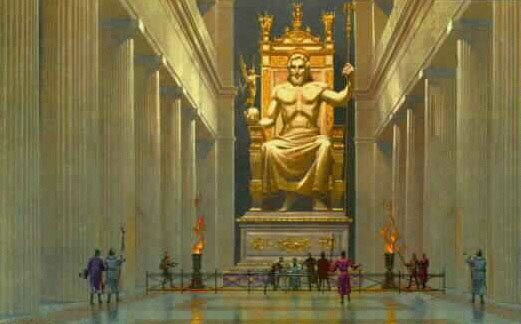|
|
|
 |
|
|
|
 |
What was it?
Imagine the beautiful setting of Olympus, the mountain home of the gods of ancient Greece, and the city of Olympia, site of the original Olympic games. What would be more fitting than building a temple to worship Zeus, the King of the Gods? But what do you do when the finished building is not fancy enough to honor him properly? If you are an ancient Greek in about 450 BC, you commission the sculptor, Phidias, to make a magnificent ivory and gold statue of the god.
Phidias created the 14m high statue of Zeus seated on his throne from a wooden framework around a pillar. This frame was covered with ivory for "skin" and gold carved with figures of animals and flowers for "clothing". Zeus held a scepter topped with a golden eagle and made using every metal known to the ancient Greeks. The throne was decorated with gold, ebony, and ivory. At the foot of the statue were piled gifts from kings and rulers to honor Zeus.

The Olympic games were held at Olympia in honor of Zeus. One hundred cattle were sacrificed at the altar in the front of the statue's temple every time the games were held. The altar where the offering took place was, by legend, where a bolt of Zeus' lightning struck the Earth.
In the year 391 AD, the Romans banned the Olympic Games and statue was moved to the the Roman city of Constantinaple. The legend has it that when workers came to move the statue it gave out a loud laugh and they ran away.